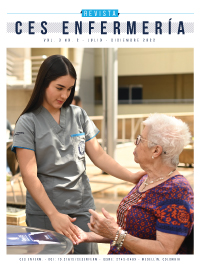Factors associated with non-fatal overdose in people who inject drugs in Colombia
DOI:
https://doi.org/10.21615/cesenferm.6480Keywords:
drug overdose, public health, addictive behaviorAbstract
Objective: to analyze the sociodemographic factors, injecting behaviors, and behaviors associated with non-fatal overdose in people who inject drugs in Colombia. Methods: cross-sectional analytical study of 1123 people who inject drugs in five cities in Colombia. The people were between the ages of 18 and 59. As a dependent variable, the presence or not of an overdose was considered. They were investigated for demographic variables and risk behaviors associated with overdose. Results: of the people who overdosed, 85,8% were men. 62,3% had secondary school studies. 61,7% are of low socioeconomic status. Factors such as selling drugs, dividing the mix, and being present when someone overdosed were characteristics that were associated with having overdosed. Conclusions: injection practices and behaviors are associated with having overdosed. Public health actions aimed at modifying some injection practices can contribute to reducing overdose and the sequences it generates.
Downloads
References
United Nations. World drug report 2015. New York: United Nations publication; 2015.
Cronquist A, Edwards V, Galea S, Latka M, Vlahov D. Health care utilization among young adult injection drug users in Harlem, New York. J Subst Abuse. 2001;13(1-2):17-27.
Organización Mundial de la Salud [Internet] Ginebra: OMS; 11 de julio de 2014 [citado 3 de julio de 2016] Disponible en: https://www.who.int/es/news/item/11-07-2014-who-people-most-at-risk-of-hiv-are-not-getting-the-health-services-they-need
Li J, Gu J, Lau JTF, Chen H, Mo PKH, Tang M. Prevalence of depressive symptoms and associated factors among people who inject drugs in China. Drug Alcohol Depend. 2015;151: 228-35.
Cravioto P, Medina-Mora ME, Rosa B de la, Galván F, Tapia-Conyer R. Patrones de consumo de heroína en una cárcel de la frontera norte de México: barreras de acceso a tratamiento. Salud Pública México. 2003;45(3):181–190.
Observatorio de Drogas de Colombia. Reporte de drogas de Colombia 2015. Edición 1. Bogotá: 2015.
Organización Mundial de la Salud [Internet] Ginebra: OMS; noviembre de 2014 [citado 21 de julio de 2016]. Disponible en: http://www.who.int/substance_abuse/information-sheet/es/
National Harm Reduction Coalition [Internet] New York: National Harm Reduction Coalition [citado 27 de julio de 2016]. Disponible en: http://harmreduction.org/issues/overdose-prevention/overview/la-prevencion-y-educacion-sobre-sobredosis-de-drogas/
Observatorio Europeo de las Drogas y las Toxicomanías. Sobredosis: una de las principales causas de muerte evitable entre los jóvenes [Internet] [citado 17 de octubre de 2016]. Disponible en: http://www.emcdda.europa.eu/system/files/publications/296/Dif13ES_63678.pdf
Winter RJ, Stoové M, Degenhardt L, Hellard ME, Spelman T, Jenkinson R, et al. Incidence and predictors of non-fatal drug overdose after release from prison among people who inject drugs in Queensland, Australia. Drug Alcohol Depend. 2015; 153:43-9.
Park JN, Weir BW, Allen ST, Chaulk P, Sherman SG. Fentanyl-contaminated drugs and non-fatal overdose among people who inject drugs in Baltimore, MD. Harm Reduct J. 2018;15(1):34.
Caudarella A, Dong H, Milloy MJ, Kerr T, Wood E, Hayashi K. Non-fatal overdose as a risk factor for subsequent fatal overdose among people who inject drugs. Drug Alcohol Depend. 2016; 162:51-5.
Britton PC, Wines JD, Conner KR. Non-fatal overdose in the 12 months following treatment for substance use disorders. Drug Alcohol Depend. 2010;107(1):51.
Heckharton D. Respondent Driven Sampling: A new approach hidden populations. Social problems. 1997;44(2): 174-199.
Oficina de las Naciones Unidas contra la Droga y el Delito. Informe Mundial sobre las Drogas 2016 [Internet] [citado 17 de octubre de 2016]. Disponible en: https://www.unodc.org/doc/wdr2016/WDR_2016_ExSum_spanish.pdf
Roth AM, Armenta RA, Wagner KD, Roesch SC, Bluthenthal RN, Cuevas-Mota J, et al. Patterns of drug use, risky behavior, and health status among persons who inject drugs living in San Diego, California: a latent class analysis. Subst Use Misuse. 2015;50(2):205-14.
Cárdenas KM, Orjuela ME, Téllez-Mosquera JA. Clinical and demographic profile of patients nursed in urgency services due to acute intoxication with psychoactive substances in Bogotá. Rev Fac Med. 2012;60(4):265–273.
Horyniak D, Dietze P, Degenhardt L, Higgs P, McIlwraith F, Alati R, et al. The relationship between age and risky injecting behaviours among a sample of Australian people who inject drugs. Drug Alcohol Depend. 2013;132(3):541-6.
Berbesi-Fernández D, Segura-Cardona Á, Montoya-Vélez L, Castaño-Perez GA. Hepatitis C and HIV in injecting drug users in Armenia, Colombia. Adicciones [Internet]. 2015 [citado 10 de octubre de 2016];27(4). Disponible en: http://search.ebscohost.com/login.aspx?direct=true&profile=ehost&scope=site&authtype=crawler&jrnl=02144840&AN=112004288&h=PSyyMaza0E2q%2Fs%2FPUncw1cYSu2D6IGpiCZbphtN9JncsNMkDKQdkh2itA9K6rfpefERaBCihAXl0vy0EfHNdog%3D%3D&crl=c
Zhang Y, Shan H, Trizzino J, Ruan Y, Beauchamp G, Mâsse B, et al. Demographic characteristics and risk behaviors associated with HIV positive injecting drug users in Xinjiang, China. J Infect. 2007;54(3):285-90.
Galea S, Nandi A, Coffin PO, Tracy M, Markham Piper T, Ompad D, et al. Heroin and cocaine dependence and the risk of accidental non-fatal drug overdose. J Addict Dis. 2006;25(3):79-87.
Lee WK, Ti L, Hayashi K, Kaplan K, Suwannawong P, Wood E, et al. Assisted injection among people who inject drugs in Thailand. Subst Abuse Treat Prev Policy. 2013;8(1):1.
Rafiey H, Narenjiha H, Shirinbayan P, Noori R, Javadipour M, Roshanpajouh M, et al. Needle and syringe sharing among Iranian drug injectors. Harm Reduct J. 2009;6(1):21.
Tun W, Sheehy M, Broz D, Okal J, Muraguri N, Raymond HF, et al. HIV and STI Prevalence and Injection Behaviors Among People Who Inject Drugs in Nairobi: Results from a 2011 Bio-behavioral Study Using Respondent-Driven Sampling. AIDS Behav. 2015;19(S1):24-35.
Rowe C, Santos G-M, Behar E, Coffin PO. Correlates of overdose risk perception among illicit opioid users. Drug Alcohol Depend. 2016; 159:234-9.
Pollini RA, McCall L, Mehta SH, Celentano DD, Vlahov D, Strathdee SA. Response to Overdose Among Injection Drug Users. Am J Prev Med. 2006;31(3):261-4.
Downloads
Published
How to Cite
Issue
Section
License
Copyright (c) 2022 CES Enfermería

This work is licensed under a Creative Commons Attribution-NonCommercial-ShareAlike 4.0 International License.
| Article metrics | |
|---|---|
| Abstract views | |
| Galley vies | |
| PDF Views | |
| HTML views | |
| Other views | |




